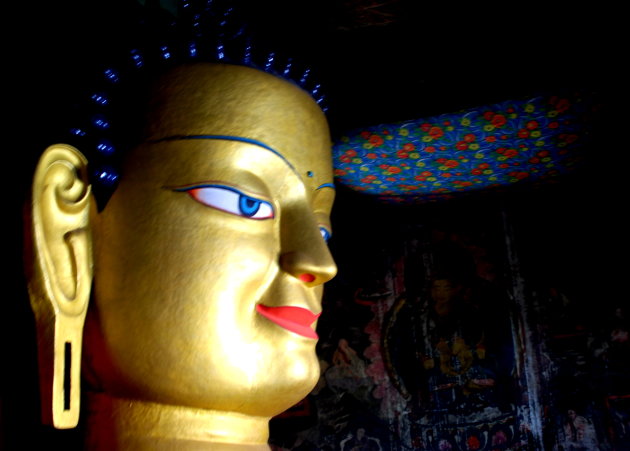
Ladakh - the land of kings, stories and the wisdom of Buddha.
There is always a special feeling when you land in a new town- a moment of exhilaration, a nervous energy that gives you a sense of high. In Ladakh however, the feeling is real. Your head feels light and you realize that the headiness is not just excitement.
It takes me almost an entire day to get acclimatized to the dizzying heights and then I give in to the magic of Ladakh. There is a beauty in the barrenness, even as the mountains crowd you. The River Indus appears, like a mirage initially and then flows along side with us, a gentle companion. We follow its course and stumble upon a carpet of green that stretches right up to the mountains. Stark and dramatic, the landscape is breathless. We leave Leh and head towards Shey, the ancient capital of the Ladakh kingdom.
Standing amidst the countless chortens or stupas that are scattered around Shey, I hear a foreign tourist narrate a story to her reluctant daughter, who is refusing to climb up the steps leading to the ruined palace of the kings. And that is where I heard about the Epic of king Gesar or Kesar, as the people of Ladakh refer to the legendary Tibetan hero sent by the Gods to defeat demons. It is believed that the mythical gLing ruled by Kesar could possibly be today’s Shey, the capital of the ancient Ladakh kingdom. Even today there are a few artistes around Ladakh and Tibet who can sing their own versions of the 1000 year old ballad.
Located about 14 kms from Leh, Shey, situated at a height of 11000 feet is now a small village on the banks of the Indus. A rock engraving representing the Five Buddhas of Meditation greets you here. Tourists flock by here to see the ancient fortifications, palace and the monastery and the imposing idols of Sakyamuni, the form of Buddha worshipped by the Sakya clan of saints.
Glittering in copper and gilded gold, the idol in the monastery is one of the largest statues in Ladakh built probably by the king Senggee Namgyal. The lama here tells us that four craftsmen were specially brought from Nepal by Gyal Katun, the king’s mother to create this deity here. “As they had married locally, they were not allowed entry into Nepal, and so even today, their descendants live in a small village called Chiling,” he says.
The sun is merciless and I collect my breath after having climbed the hillock where the monastery is housed. A row of prayer wheels, mani walls and chortens fill the landscape as I look down. The Indus is a sheet of light blue, adding a dash of colour to the valley.
We sit on the steps and take in the landscape.
Several dynasties have ruled Shey besides the mythical hero Kesar and his descendants. However historically, Ladakh came under Tibetan rule around the 10th century when Nyima Gon, established his empire here and built probably a few chortens in Shey. It is ironic, said the lama I was chatting with, that Tibet itself was in turmoil after Nyima Gon’s grandfather; King Lang Darma was murdered by a seer for apparently persecuting Buddhists.
The flags flutter in the breeze while the shutterbugs are busy taking pictures of the valley below. I am told the monastery here was built much later by the Namgyal rulers. The lama tells me that somewhere in the middle of 16th century, Ladakh was a divided kingdom ruled from both Shey and Basgo. The king from Basgo, Bhagan deposed the Shey ruler and titled himself Namgyal or Victorious. It was during this dynasty’s reign that power slowly shifted from Shey to Leh, with a palace being built in Leh. And like any erstwhile capital, town, Shey slowly lost its strategic significance. “When the Nangyals finally lost power to the Kashmir kings and to Mughals, Shey was abandoned.” There was a ring of finality in his tone. As he walks away, I look down to see several tourists rotating the prayer wheel as they climb up. Shey is probably now just another must see destination in their sightseeing list.
Lakshmi Sharath is a media professional, a traveler, travel writer and blogger. After 15 years of sitting in front of a desk in several media organizations, she decided to travel and see the world. Since then she has covered 20 countries across five continents; her passion lies in exploring the nooks of India.
No comments:
Post a Comment